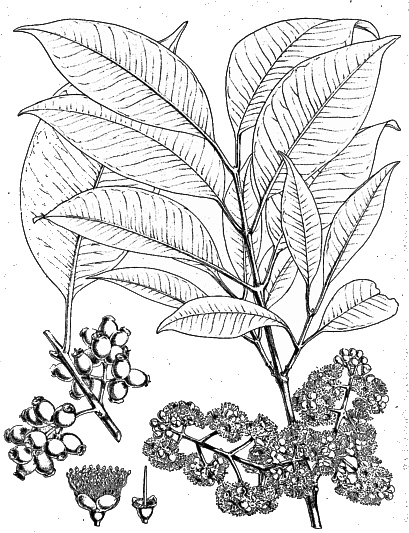

Zitierweise / cite as:
Carakasaṃhitā: Ausgewählte Texte aus der Carakasaṃhitā / übersetzt und erläutert von Alois Payer <1944 - >. -- Anhang A: Pflanzenbeschreibungen. -- Syzygium cumini (L.) Skeels. -- Fassung vom 2007-07-27. -- URL: http://www.payer.de/ayurveda/pflanzen/syzygium_cumini.htm
Erstmals publiziert: 2007-07-27
Überarbeitungen:
Anlass: Lehrveranstaltung SS 2007
©opyright: Dieser Text steht der Allgemeinheit zur Verfügung. Eine Verwertung in Publikationen, die über übliche Zitate hinausgeht, bedarf der ausdrücklichen Genehmigung des Verfassers
Dieser Text ist Teil der Abteilung Sanskrit von Tüpfli's Global Village Library
WARNUNG: dies ist der Versuch einer
Übersetzung und Interpretation eines altindischen Textes. Es ist keine
medizinische Anleitung. Vor dem Gebrauch aller hier genannten Heilmittel wird
darum ausdrücklich gewarnt. Nur ein erfahrener, gut ausgebildeter ayurvedischer
Arzt kann Verschreibungen und Behandlungen machen!
Falls Sie die diakritischen Zeichen nicht dargestellt bekommen, installieren Sie eine Schrift mit Diakritika wie z.B. Tahoma.
Verwendete und zitierte Werke siehe: http://www.payer.de/ayurveda/caraka0001.htm

Abb.: Syzygium cumini (L.) Skeels = Wachs-Jambuse
[Bildquelle: Wikipedia]
Drury:
"Syzygium Jambolanum (Dec.) N. O. Myrtaceae. Nawel, Tam. Perin-njara, Mal. Jamoon, Hind. Kallajam, Beng. Naredoo, Tel.
Description.—Tree ; leaves oval or oblong, more or less acuminated or obtuse, feather - nerved, coriaceous ; cymes panicled, lax, usually lateral on the former year's branches, occasionally axillary or terminal; calyx shortly turbinate, truncated ; berry olive-shaped, often oblique ; flowers small, white. Fl. March.—Jr. W. & A. Prod. 1. 329.— Wight Icon. t. 535, 553,—Eugenia Jambolana, Lam.—Wight Ill. ii 16.— Roxb. Fl. Ind. ii. 484—S. caryophyllifolium, Dec.—Rheede, v. t. 29.-------Peninsula. Bengal Tinnevelly.
Medical Uses.—The bark possesses astringent properties, and in the form of decoction is much used in Bengal in chronic dysentery. A syrup prepared with the juice of the ripe fruit is a pleasant stomachic, and acts as an efficient astringent in chronic diarrhoea.— Pharm. of India.
Economic Uses.—The timber is fine, hard, and close-grained. The hark dyes excellent durable browns of various shades according to. the mordaunt employed, or the strength of the decoction.—(Roxb. Wight.) The tree attains its full size in 40 years. The wood is dark red, slightly liable to warp, but not subject to worms. It is used for agricultural implements.—(Balfour.) It does not rot in water, and thence is used in Ajmere to line wells.—(Fleming.) A communication was made to the Agri. Hort Soc. of Beng. (Jan. 1864) stating that with the fruit called Jamoon the writer had made in Barapore Bauleah a wine, that for its qualities and taste was almost similar to the Wine made from the grape. The wine was very cheap, as from two maunds of the fruit collected about one maund of wine was made, which cost altogether three rupees."
[Quelle: Drury, Heber <1819 - 1872>: The useful plants of India : with notices of their chief value in commerce, medicine, and the arts. -- 2d ed. with additions and corrections. London : Allen, 1873. -- xvi, 512 p. ; 22 cm. -- s.v.]